
Short-Term Associations Between Fine Particulate Air Pollution and Cardiovascular and Respiratory Mortality in 337 Cities in Latin America
This study documents associations between increases in fine particulate air pollution (PM2.5) and mortality due to cardiovascular and respiratory diseases in adults in 337 cities across nine countries in Latin America. Specifically, a 10 μg/m3 increase in PM2.5 was associated with a 1.3% and a 0.9% increase in CVD and respiratory mortality, respectively. Increases in mortality were larger in men and associations with cardiovascular mortality were stronger at older ages. Published in the April 2024 issue of Science of The Total Environment.
Read

Associations Between Urban Greenspace and Depressive Symptoms in Mexico’s Cities Using Different Greenspace Metrics
This study sheds light on the relationship between neighborhood greenness and mental health and depression in cities across Mexico. The authors examined connections between neighborhood greenspace and depressive symptoms among more than 17,000 urban residents in 84 large cities across Mexico. Key findings indicate that higher levels of neighborhood “greenness” (measured using the Normalized Difference Vegetation Index or NDVI) were associated with almost 10% lower odds of experiencing depressive symptoms. Published in the March 2024 issue of Applied Geography.
Read

A Scaling Investigation of Urban Form Features in Latin America Cities
Urban growth is characterized by many features that evolve over time. Leveraging SALURBAL data for 371 cities across the region, this paper examines the relationships between population size and city landscape and street design. The authors also explore the potential influence of colonization on the current built environment.
Read
Download (English PDF)

Ambient nitrogen dioxide in 47K neighbourhoods across 326 cities in eight Latin American countries: population exposures and associations with urban features
This paper examines levels of nitrogen dioxide (NO2) exposure across 47,000 Latin American neighborhoods and finds that over 200 million residents are exposed to NO2 levels that exceed WHO guidelines. Increasing neighborhood-level greenness and reducing reliance on fossil fuel-powered vehicles have potential as actionable interventions to safeguard health and support climate change mitigation.
Read

Greenness and excess deaths from heat in 323 Latin American cities: Do associations vary according to climate zone or green space configuration?
Using data from 323 Latin American cities and meta-regression models, this paper explores associations between city-level greenness and excess deaths from heat. Findings suggest that greenness may offer modest protection against heat-related mortality in arid climate zone Latin American cities.
Read
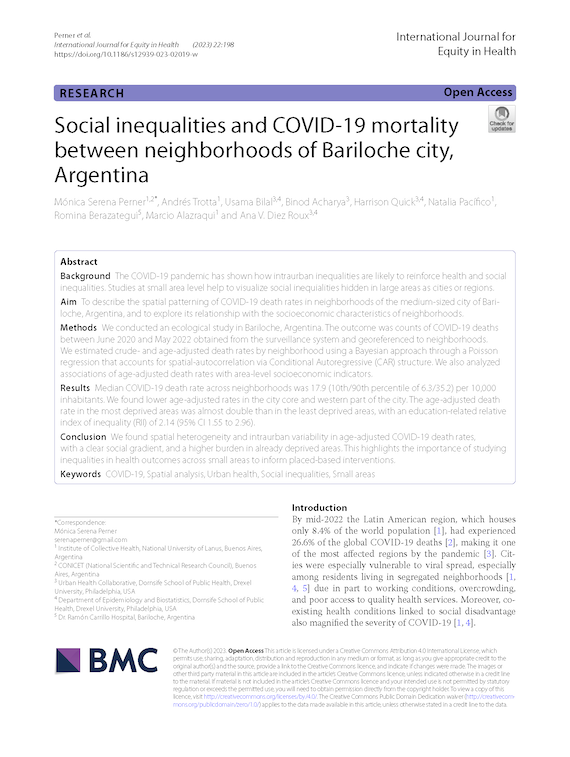
Social inequalities and COVID-19 mortality between neighborhoods of Bariloche city, Argentina
This article describes the spatial patterning of COVID-19 death rates in neighborhoods of the medium-sized city of Bariloche, Argentina, and explores connections between mortality and neighborhood socioeconomic characteristics.
Read

Recent greening may curb urban warming in Latin American cities of better economic conditions
Results from this paper provide insights into the urban warming mechanism manifested through the effect of economic conditions on urban green space, for Latin American cities and other high-density cities transforming in a similar context.
Read
Download (English PDF)

Social environment characteristics are related to self-rated health in four Latin America countries: Evidence from the SALURBAL Project
This paper investigates the associations of social and built environment and demographic features of urban areas with self-rated health among adults living in four Latin American countries.
Read
Download (English PDF)

Spatial data collection and qualification methods for urban parks in Brazilian capitals: An innovative roadmap
This study designed a systematized methodology to identify processes of accessing, collecting, verifying, and harmonizing urban park spatial data in all Brazilian capitals included in the Urban Health in Latin America (SALURBAL) project.
Read
Download (English PDF)

Gender differences in the association of individual and contextual socioeconomic status with hypertension in 230 Latin American cities from the SALURBAL study: a multilevel analysis
This study examines associations of individual- and area-level socioeconomic status with hypertension in adults living in 230 cities in eight Latin America countries.
Read
Download (English PDF)

Effects of an urban cable car intervention on physical activity: the TrUST natural experiment in Bogotá, Colombia
This paper assessed the effects of TransMiCable, he first cable car in Bogotá, Colombia, and the wider intervention on physical activity.
Read
Download (English PDF)
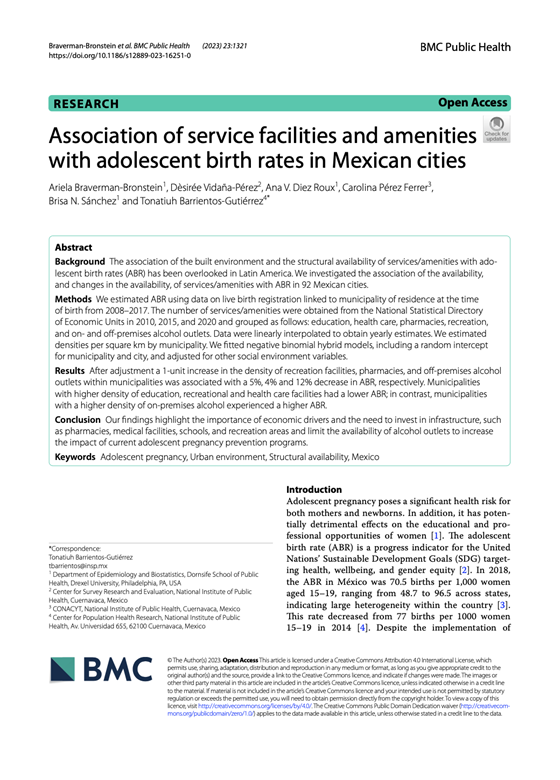
Association of service facilities and amenities with adolescent birth rates in Mexican cities
This paper investigates the association of the availability, and changes in the availability, of services/amenities with adolescent birth rates in 92 Mexican cities.
Read
Download (English PDF)

Evaluating the effects of social capital on travel behavior: Modeling the choice of an innovative transport mode
This paper aims to evaluate the effects of social capital on the willingness to use a new cable car service in Bogotá (Colombia) that connects the Bus Rapid Transit system with a vulnerable zone with low accessibility.
Read
Download (English PDF)

Trends in food and beverage purchases in informal, mixed, and formal food outlets in Mexico: ENIGH 1994–2020
This paper estimates the trends of food and beverage purchases in outlets of the mixed, formal, and informal food sectors from 1994 to 2020 using Mexico’s National Income and Expenditure Surveys (ENIGH) and evaluates whether these trends differed across socioeconomic and urbanicity strata.
Read
Download (English PDF)

Spatial Inequities in Life Expectancy in Small Areas of Buenos Aires, Argentina 2015–2017
This paper analyzed the distribution and spatial patterning of life expectancy across small areas of Ciudad Autónoma de Buenos Aires (CABA), Argentina, and its association with socioeconomic characteristics.
Read
Download (English PDF)

Desarrollo de instrumentos para estudiar el impacto en salud de las transformaciones urbanas en contextos de elevada vulnerabilidad: el estudio RUCAS
Este artículo describe el proceso de diseño y las características de un cuestionario y una pauta de observación intradomiciliaria desarrollados para evaluar tanto transversal como longitudinalmente la relación vivienda-barrio-salud en el marco de transformaciones urbanas llevadas a cabo en poblaciones de elevada vulnerabilidad socio-territorial.
Read
Download (English PDF)

Lifting urban mobility for the poor: Cable-cars, travel satisfaction and subjective well-being
This paper addresses how travel satisfaction, neighborhood satisfaction, and social capital relate to life satisfaction among a low-income community in Bogotá (Colombia) as a case study.
Read
Download (English PDF)

“Mi vida va a ser mucho mejor de lo que ha sido”: estudio cualitativo sobre el vínculo entre regeneración de viviendas sociales, calidad de vida y salud
El estudio buscaba conocer el vínculo entre la vivienda, la salud y la calidad de vida en un contexto de regeneración de viviendas sociales, a partir de las experiencias y percepciones de sus habitantes, indagando en aquellos mecanismos que sostienen este vínculo antes de la regeneración, y en aquellos elementos derivados de la regeneración de la vivienda que se materializan en mejoras en la calidad de vida y potencialmente en la salud.
Read
Download (English PDF)
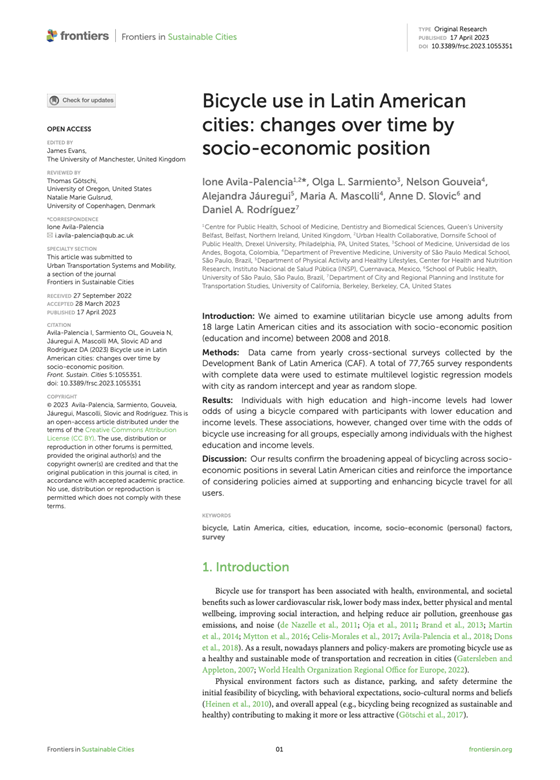
Bicycle use in Latin American cities: changes over time by socio-economic position
The study examines utilitarian bicycle use among adults from 18 large Latin American cities and its association with socio-economic position (education and income) between 2008 and 2018.
Read
Download (English PDF)

Assessing cohesion and diversity in the collaboration network of the SALURBAL project
The SALURBAL (Urban Health in Latin America) Project is an interdisciplinary multinational network aimed at generating and disseminating actionable evidence on the drivers of health in cities of Latin America. This paper conducts a temporal multilayer network analysis where they measured cohesion over time using the structural properties of the network and assessed diversity within and between different project activities according to participant attributes.
Read
Download (English PDF)

City features related to obesity in preschool children: a cross-sectional analysis of 159 cities in six Latin American countries
This study aims to examine the association of features of the built and social environment with excess weight in pre-school children by using city and sub-city level data from almost 160 cities in six Latin American countries.
Read
Download (English PDF)

Fostering capacity building and multidisciplinary urban health research in Latin America
This article was published as a part of the Special Issue of Cities and Health
Read
Download (English PDF)

Gender differences in the association of individual and contextual socioeconomic status with hypertension in 230 Latin American cities from the SALURBAL study: a multilevel analysis
The objective of this study was to examine associations between the individual- and area-level socioeconomic status and hypertension in adults living in 230 cities in eight Latin America countries.
Read
Download (English PDF)

Socioeconomic Urban Environment in Latin America: Towards a Typology of Cities
This paper aims to identify typologies of Latin American cities based on socioeconomic urban environment patterns. We used census data from 371 urban agglomerations in 11 countries included in the SALURBAL project to identify socioeconomic typologies of cities in Latin America.
Read
Download (English PDF)

Variation in youth and young adult homicide rates and their association with city characteristics in Latin America: the SALURBAL study
This study aimes to describe homicide rates among youth and young adults, as well as their association with socioeconomic and built environment factors across 315 cities in eight LAC countries.
Read
Download (English PDF)

The impact of social violence on HIV risk for women in Colombia: A concurrent mixed methods study
This study seeks to understand how violence is associated with newly reported HIV/AIDS case rates for women in Colombian municipalities; and describe how social violence impacts HIV risk, treatment, and prevention for Venezuelan migrant and refugee women undergoing transnational migration and resettlement in Colombia.
Read
Download (English PDF)

Making the invisible, visible: Race, Racism and Health Data
To advance research and action on racial/ethnic health inequities in Latin American countries, local, state, and national decision-makers must improve the collection of high-quality data on race and ethnicity and make it available to researchers and all society.
Download (English PDF)
Descargar (Español PDF)
Baixar (Português PDF)

Commuter's personal exposure to air pollutants after the implementation of a cable car for public transport: Results of the natural experiment TrUST
This study assesses the personal exposure to fine particulate matter (PM2.5), equivalent Black Carbon (eBC), and Carbon Monoxide (CO) in transport micro-environments and to estimate the inhaled dose per trip during mandatory multimodal trips before and after the implementation of the TransMiCable.
Read
Download (English PDF)

Reformulation of Top-Selling Processed and Ultra-Processed Foods and Beverages in the Peruvian Food Supply after Front-of-Package Warning Label Policy
This study explores changes in the content of nutrients of concern (sugar, saturated fat, trans fat, and sodium) and the percentage of products in the Peruvian food supply that would carry a FOPWL before and after Peru’s implementation of FOPWLs.
Read
Download (English PDF)

The urban built environment and adult BMI, obesity, and diabetes in Latin American cities
This study evaluates the association of built environment characteristics at the sub-city —intersection density, greenness, and population density— and city-level —fragmentation and isolation— with body mass index (BMI), obesity, and type 2 diabetes (T2D).
Read
Download (English PDF)

Smoking Ban Law in Chile: Impact in Newborns’ Birth Weight by Women’s Age Groups and by City Population Density
This study examines the short-term impact of the Smoking Ban Law (SBL) enacted in Chile in 2013 on low birth weight (LBW) rates in cities and its differential effects by different maternal age groups and city density.
Read
Download (English PDF)

One-year impact of a multicomponent, street-level design intervention in Mexico City on pedestrian crashes: a quasi-experimental study
Mexico City implemented the Pasos Seguros program to prevent pedestrian injuries and deaths at dangerous road intersections. This study assesses the effectiveness of the Pasos Seguros program at reducing total, injury and fatal pedestrian-motor vehicle crashes.
Read
Download (English PDF)

Gender inequality, women's empowerment, and adolescent birth rates in 363 Latin American cities
This study investigated the associations of urban measures of women's empowerment and gender inequality with adolescent birth rates (ABR) in 366 Latin American cities in nine countries.
Read
Download (English PDF)

Association of urban inequality and income segregation with COVID-19 mortality in Brazil
This study analyzes the effect of income inequality and income segregation on COVID–19 mortality in large urban centers in Brazil.
Read
Download (English PDF)

Evaluation of the national sobriety checkpoints program in Mexico: a difference-in-difference approach with variation in timing of program adoption
This study measured the association between the sobriety checkpoints program and road traffic mortality rates in 106 urban municipalities in Mexico.
Read
Download (English PDF)

Are Women’s Empowerment and Income Inequality Associated with Excess Weight in Latin American Cities?
This study analyzed gender-specific associations between city-level women’s empowerment and income inequality with individual-level overweight/obesity, assessing how these associations vary by individual education or living conditions within cities in Latin America.
Read
Download (English PDF)

Health and Environmental Co-Benefits of City Urban Form in Latin America: An Ecological Study
This study investigates the association of urban landscape profiles with health and environmental outcomes, and whether those profiles are linked to environmental and health co-benefits.
Read
Download (English PDF)
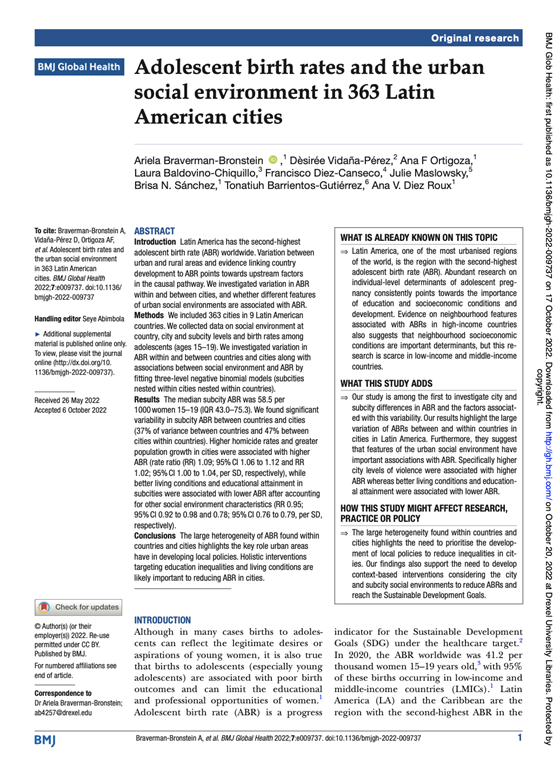
Adolescent birth rates and the urban social environment in 363 Latin American cities
This study investigates variation in Adolescent Birth Rate (ABR) within and between cities, and whether different features of urban social environments are associated with ABR.
Read
Download (English PDF)
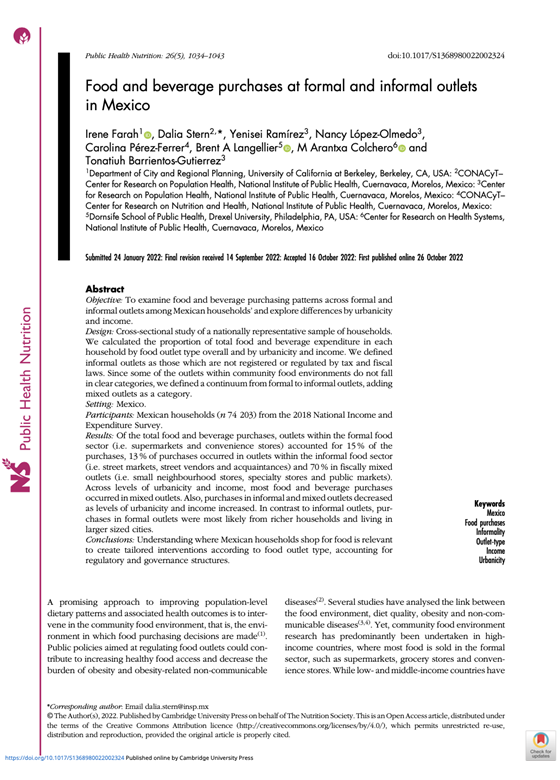
Food and beverage purchases at formal and informal outlets in Mexico
This study examines food and beverage purchasing patterns across formal and informal outlets among Mexican households’ and explores differences by urbanicity and income.
Read
Download (English PDF)

Marketing techniques, health, and nutritional claims on processed foods and beverages before and after the implementation of mandatory front-of-package warning labels in Peru
This study describes changes in marketing strategies on packaging: marketing techniques (MT), health claims (HC), and nutritional claims (NC) on the packaging of products frequently consumed by children before and after the FOPL implementation.
Read
Download (English PDF)

Áreas Verdes y el Cambio Climático: Estrategias de adaptación y mitigación en los municipios de América Latina y el Caribe
This brief describes municipal adaptation and mitigation efforts developed by cities across Latin America, and highlights a series of actions leveraging urban greenspaces and public-private partnerships to promote health and wellbeing and respond to climate change.
Descargue (Spanish PDF)
Versão em português em breve

City-Level Travel Time and Individual Dietary Consumption in Latin American Cities: Results from the SALURBAL Study
This study investigates whether longer travel times at the city level are associated with lower consumption of vegetables and higher consumption of sugar-sweetened beverages and if this association differs by city size.
Read
Download (English PDF)
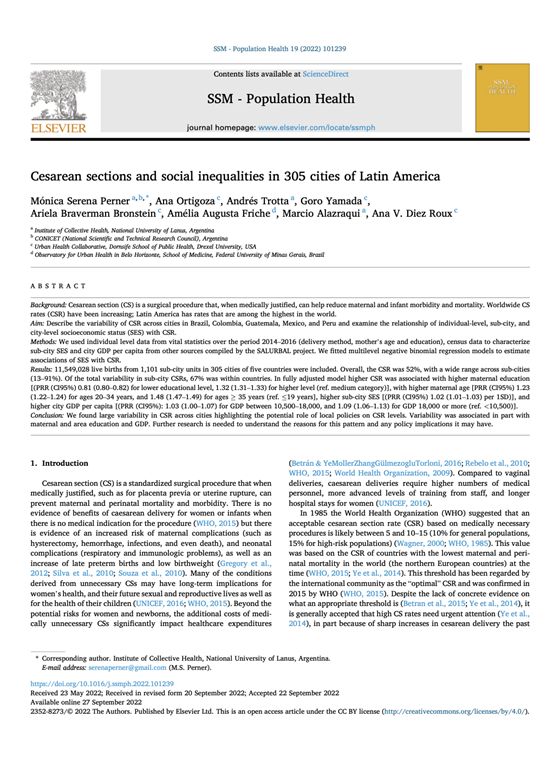
Cesarean sections and social inequalities in 305 cities of Latin America
This study describes the variability of CSR across cities in Brazil, Colombia, Guatemala, Mexico, and Peru and examines the relationship of individual-level, sub-city, and city-level socioeconomic status (SES) with CSR.
Read
Download (English PDF)
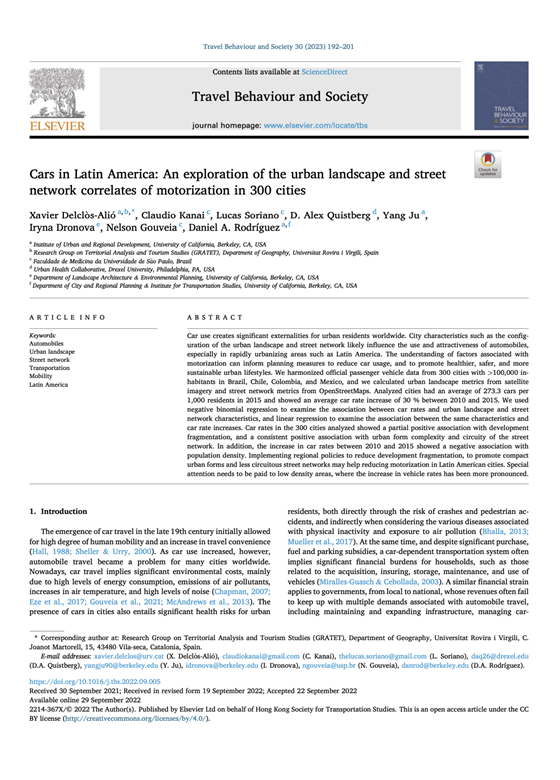
Cars in Latin America: An exploration of the urban landscape and street network correlates of motorization in 300 cities
This study harmonizes official passenger vehicle data from 300 cities with >100,000 inhabitants in Brazil, Chile, Colombia, and Mexico, and calculates urban landscape metrics from satellite imagery and street network metrics from OpenStreetMaps.
Read
Download (English PDF)
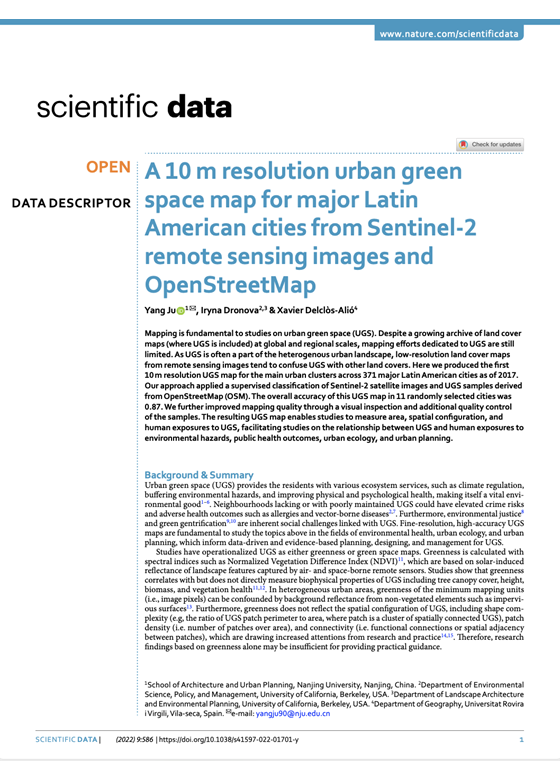
A 10 m resolution urban green space map for major Latin American cities from Sentinel-2 remote sensing images and OpenStreetMap
This study produces the first 10 m resolution UGS map for the main urban clusters across 371 major Latin American cities as of 2017.
Read
Download (English PDF)

Inequality and income segregation in Brazilian cities: a nationwide analysis
This study assesses income segregation in the 152 largest Brazilian cities in the SALURBAL Project.
Read
Download (English PDF)

An Experimental Study Evaluating the Influence of Front-of-Package Warning Labels on Adolescent's Purchase Intention of Processed Food Products
The aim of this study was to assess, using an experimental design, whether WLs influence purchase intention of processed foods and identification of the healthiest products among adolescents in Peru, in May 2019, just before WLs mandatory implementation.
Read
Download (English PDF)

Evaluation of road safety policies and their enforcement in Mexico City, 2015–2019: an interrupted time-series study
This study evaluates Mexico City's Road satefy policies (2015) on road traffic collisions, injuries and deaths.
Read
Download (English PDF)

Intraurban socioeconomic inequalities in life expectancy: a population-based cross-sectional analysis in the city of Córdoba, Argentina (2015–2018)
This paper evaluates variability in life expectancy at birth in small areas, describes the spatial pattern of life expectancy and examines associations between small-area socioeconomic characteristics and life expectancy in a mid-sized city of a middle-income country.
Read
Download (English PDF)

Is city-level travel time by car associated with individual obesity or diabetes in Latin American cities? Evidence from 178 cities in the SALURBAL project
This paper estimated associations between peak hour city-level travel time by car and obesity and diabetes using multilevel logistic regression models, while adjusting for individual characteristics and other city-level covariates.
Read
Download (English PDF)

Socioeconomic deprivation and changes in the retail food environment of Mexico from 2010 to 2020
This paper analyzes the change in the retail food environment of Mexican municipalities from 2010 to 2020, and to assess if these trends were modified by socioeconomic deprivation.
Read
Download (English PDF)
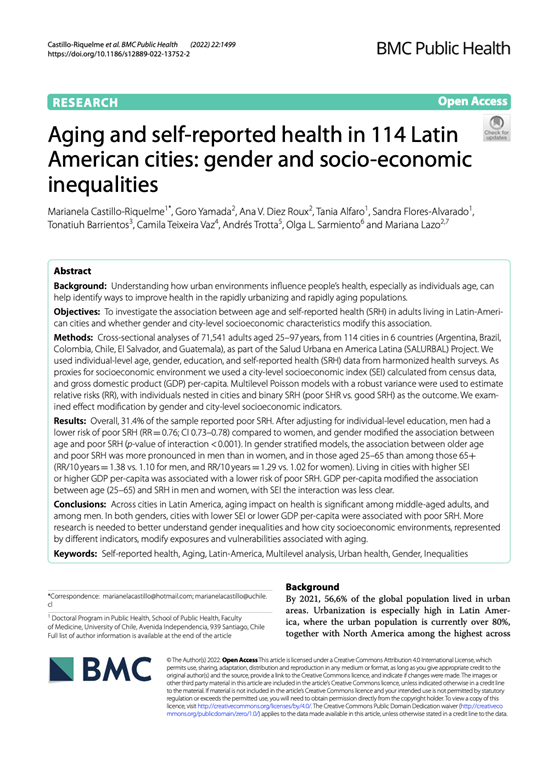
Aging and self-reported health in 114 Latin American cities: gender and socio-economic inequalities
This paper investigates the association between age and self-reported health (SRH) in adults living in Latin-American cities and whether gender and city-level socioeconomic characteristics modify this association.
Read
Download (English PDF)

Density of alcohol-selling outlets and prices are associated with frequent binge drinking in Mexico
This paper estimates the association between density of alcohol outlets, price of alcoholic beverages, and binge drinking in Mexico among the population aged 12 to 65 years old who consumed alcohol during the last 12 months.
Read
Download (English PDF)

Transformaciones Urbanas y Salud (TrUST): Resultados de la evaluación del TransMiCable durante la pandemia por COVID-19
El estudio TrUST busca comprender cómo el TransMiCable y las transformaciones urbanas asociadas impactan la salud, la movilidad y la calidad de vida de la comunidad en la zona de influencia del cable aéreo en Ciudad Bolívar, Bogotá, Colombia.
Descargar (Spanish PDF)

Excess Mortality during the COVID-19 Pandemic in Cities of Chile: Magnitude, Inequalities, and Urban Determinants
This paper estimates excess mortality in Chilean cities during the COVID-19 pandemic and its association with city-level factors.
Read
Download (English PDF)

Urban transformations, community participation, and health: inter-sectoral and cross-country learning experience between Brazil, Chile, and Colombia
The focus of this paper is a September 2021 Diálogos SALURBAL event, ‘Urban transformations, community participation, and health: Lessons from Brazil, Chile, and Colombia’, which involved the research teams, public officials and community members representing urban intervention areas from each country.
Read
Download (English PDF)

Ambient temperature and term birthweight in Latin American cities
This paper explores associations between extreme temperatures and birthweight across urban areas in Brazil, Chile, and Mexico. The authors find that higher temperatures were associated with lower birthweight, and emphasize the role of exposure to extreme temperatures during months 7-9 of gestation.
Read
Download (English PDF)

Satisfaction and perceptions about aspects of the city that affect health, by socioeconomic status, 2010-2019, in Lima
This publication aims to characterize the satisfaction and perceptions of the residents of Lima about different aspects of urban life that can affect their quality of life and health, identifying differences by socioeconomic status (SES) and changes over time.
Read
Download (English PDF)
Descargar (Spanish PDF)
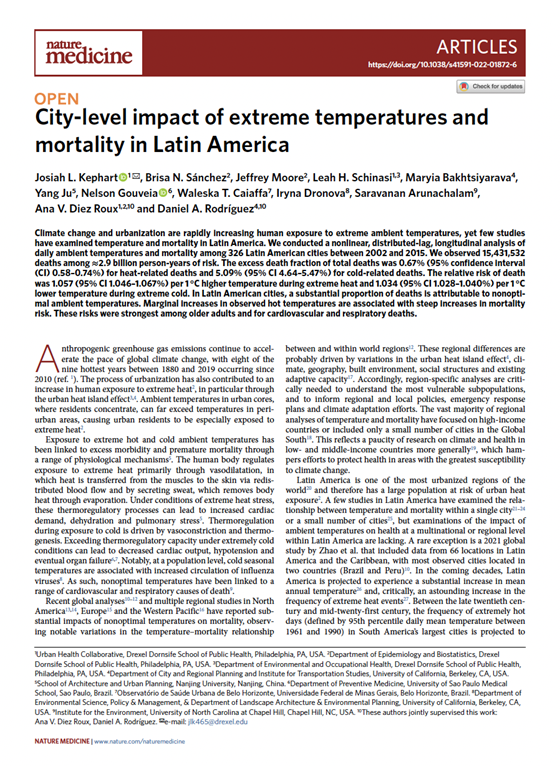
City-level impact of extreme temperatures and mortality in Latin America
This publication highlights the effects of extreme temperatures on mortality for urban populations in in 326 cities across nine countries in Latin America.
Read
Download (English PDF)
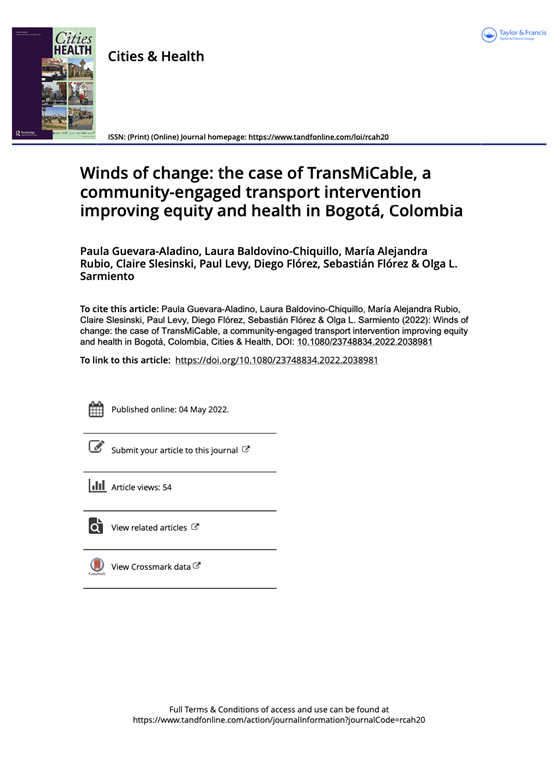
Winds of change: the case of TransMiCable, a community-engaged transport intervention improving equity and health in Bogotá, Colombia
This publication tests the association between informal employment and major depressive symptoms in LAC cities.
Read
Download (English PDF)

Association between informal employment and depressive symptoms in 11 urban cities in Latin America
This publication tests the association between informal employment and major depressive symptoms in LAC cities.
Read
Download (English PDF)

Climate Change and Urban Health
Urban areas across Latin America face increasing health impacts from climate change. This brief describes what we know about the current and future impacts of climate change on health and health equity, what some cities in Latin America are doing to maximize the co-benefits of climate action, and what urban policymakers and public health researchers can do to support effective urban policies and interventions.
Download (English PDF)
Descargar (Español PDF)
Baixar (Português PDF)

Greenhouse Gas Emissions Associated With the Mexican Diet: Identifying Social Groups With the Largest Carbon Footprint
This paper estimates total dietary greenhouse gas emissions (GHGE) in Mexico, examines the contribution of major food and beverage groups, and assesses variation across social groups.
Read
Download (English PDF)

Racial Inequities in Self-Rated Health Across Brazilian Cities: Does Residential Segregation Play a Role?
This paper investigates whether individual-level self-rated health (SRH) varies by race and whether city-level economic or racial residential segregation interacts with race, increasing racial inequities in SRH.
Read
Download (English PDF)

Associations of Urban Environment Features with Hypertension and Blood Pressure across 230 Latin American Cities
This paper examines associations of urban physical environment features with hypertension and blood pressure measures in adults across 230 Latin American cities.
Read
Download (English PDF)

Urban landscape and street-design factors associated with road-traffic mortality in Latin America between 2010 and 2016 (SALURBAL): an ecological study
This paper determines associations between city-level built environment factors and road-traffic mortality in large Latin American cities.
Read
Download (English PDF)
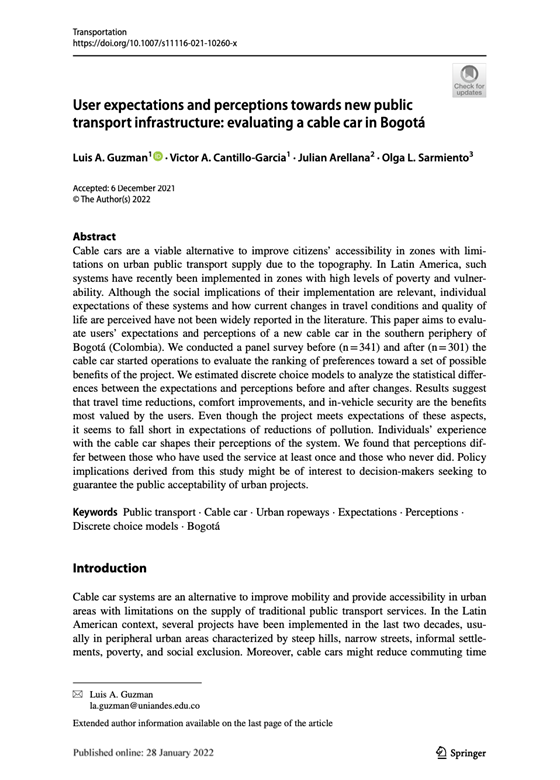
User expectations and perceptions towards new public transport infrastructure: evaluating a cable car in Bogotá
This paper evaluates users’ expectations and perceptions of a new cable car in the southern periphery of Bogotá (Colombia).
Read
Download (English PDF)

Changes in the Retail Food Environment in Mexican Cities and Their Association with Blood Pressure Outcomes
The present study examined neighborhood changes in three types of food retail stores from 2010 to 2016 in Mexico, and their association with arterial blood pressure measured in 2016.
Read
Download (English PDF)

An Experimental Study Evaluating the Influence of Front-of-Package Warning Labels on Adolescent’s Purchase Intention of Processed Food Products
This publication seeks to assess, using an experimental design, whether WLs influence purchase intention of processed foods and identification of the healthiest products among adolescents in Peru, in May 2019, just before WLs mandatory implementation.
Read
Download (English PDF)

Potential impacts of policies to reduce purchasing of ultra-processed foods in Mexico at different stages of the social transition: an agent-based modelling approach
This publication develops a simulation framework for assessing how combinations of taxes, nutrition warning labels and advertising levels could affect purchasing of ultra-processed foods (UPF) in Latin American countries and to understand whether policies reinforce or reduce pre-existing social disparities in UPF consumption.
Read
Download (English PDF)

Is self-reported park proximity associated with perceived social disorder? Findings from eleven cities in Latin America
This publication examines associations between self-reported park proximity with perceived social disorder (drug use/sales, gangs, prostitution and assault and/or crime), and whether these associations are modified by neighborhood characteristics (informal neighborhoods, poor street-lighting, abandoned buildings, illegal dumping).
Read
Download (English PDF)

Are Wealthier Times Healthier in Cities? Economic Fluctuations and Mortality in Urban Areas of Latin America
This publication analyzed data from 340 urban areas in ten countries: Argentina, Brazil, Chile, Colombia, Costa Rica, Guatemala, Mexico, Panama, Peru, and El Salvador. It used panel models adjusted for space‐invariant and time‐invariant factors to examine whether changes in area gross domestic product (GDP) per capita were associated with changes in mortality.
Read
Download (English PDF)

Scaling of mortality in 742 metropolitan areas of the Americas
This publication explores how mortality scales with city population size using vital registration and population data from 742 cities in 10 Latin American countries and the United States.
Read
Download (English PDF)

Early childhood development and urban environment in Mexico
This study explores the associations between characteristics of the urban environment and ECD in 2,194 children aged 36 to 59 months living in urban municipalities in Mexico
Read
Download (English PDF)

The equigenic effect of greenness on the association between education with life expectancy and mortality in 28 large Latin American cities
This publication examines whether urban greenness modifies the associations between area-level education, as a proxy for socioeconomic status, and life expectancy and cause-specific mortality in Latin American cities.
Read
Download (English PDF)

Disentangling associations between vegetation greenness and dengue in a Latin American city: Findings and challenges
This publication examines the association between dengue incidence and satellite-based vegetation greenness in 3826 census tracts nested in 474 neighborhoods in Belo Horizonte, Brazil, during the 2010 dengue epidemic.
Read
Download (English PDF)

The effect of population mobility on COVID-19 incidence in 314 Latin American cities: a longitudinal ecological study with mobile phone location data
This publication examines the longitudinal associations between population mobility and COVID-19 incidence at the subcity level across a large number of Latin American cities.
Read
Download (English PDF)

Latin American cities with higher socioeconomic status are greening from a lower baseline: evidence from the SALURBAL project
This publication measures the quantity and quality of green space as greenness from satellite-derived Normalized Difference Vegetation Index, and models the relationship between greenness and SES in 371 major Latin American cities between 2000 and 2015.
Read
Download (English PDF)

Educational inequalities, urbanicity and levels of non-communicable diseases risk factors
This publication investigates a) whether urbanicity is associated with individual-level non-communicable diseases (NCD) risk factors and whether urbanicity modifies trends over time in risk factors; and (b) whether educational inequalities in NCD risk factors change over time or are modified by province urbanicity.
Read
Download (English PDF)

Using cause-effect graphs to elicit expert knowledge for cross-impact balance analysis
This paper presents a novel, visually oriented questionnaire developed to elicit expert knowledge about the relationships between key factors in a system, for the purpose of CIB analysis.
Read
Download (English PDF)

Walking for transportation in large Latin American cities
This publication aimed to quantify self-reported walking for transportation in Mexico City, Bogota, Santiago de Chile, Sao Paulo, and Buenos Aires, by identifying both walking trips that are conducted entirely on foot and walking events involved in trips mainly conducted on other means of transportation (e.g. private vehicle, public transit) among individuals ≥5-years old.
Read
Download (English PDF)

Mortality amenable to healthcare in Latin American cities
This study examined the variation in city-level amenable mortality, i.e. mortality due to conditions that can be mitigated in the presence of timely and effective healthcare, in 363 Latin American cities and measured associations between amenable-mortality rates and urban metrics.
Read
Download (English PDF)

Inclusión social y actividad física en las ciclovías recreativas en América Latina
La publicación compara las trayectorias espaciales de cuatro programas de la Ciclovía Recreativa en América Latina (Bogotá, Ciudad de México, Santiago de Cali y Santiago de Chile) según las características socioeconómicas y la segregación urbana de estas ciudades; y evalua la relación entre los niveles de actividad física de los participantes y las características sociodemográficas.
Descargar (Español PDF)

Climate Trends and Consumption of Foods and Beverages by Processing Level in Mexican Cities
SALURBAL researchers analyzed 3,312 participants of the 2012 Mexican National Health and Nutrition Survey with dietary intake and sociodemographic information linked to historical rainfall and temperature data collected by the Mexican National Weather Service.
Read
Download (English PDF)

Is the built-environment at origin, on route, and at destination associated with bicycle commuting? A gender-informed approach
SALURBAL researchers examined associations of individual-, neighborhood- and city-level education -as proxies of SES at different levels-, with diabetes, hypertension, obesity, smoking and binge drinking (non-communicable disease risk factors -NCD/RF) among Argentinian adults.
Read
Download (English PDF)

Urban social determinants of non-communicable diseases risk factors in Argentina
SALURBAL researchers examined associations of individual-, neighborhood- and city-level education -as proxies of SES at different levels-, with diabetes, hypertension, obesity, smoking and binge drinking (non-communicable disease risk factors -NCD/RF) among Argentinian adults.
Read
Download (English PDF)

From Causal Loop Diagrams to Future Scenarios: Using the Cross-Impact Balance Method to Augment Understanding of Urban Health in Latin America
SALURBAL recruited 16 food and transportation system experts spanning private, academic, non-government, and policy sectors from six Latin American countries to complete an interviewer-assisted questionnaire to elicit participants’ perceptions about the bivariate relationships between 11 factors in the food and transportation system. Using cross-impact balance analysis, researchers identified 21 plausible future scenarios for the system.
Read
Download (English PDF)
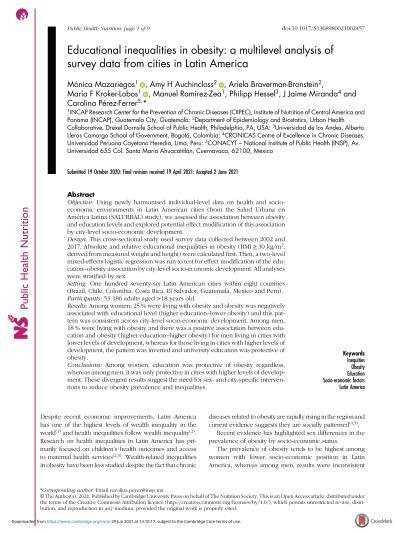
Educational Inequalities in Obesity: A Multilevel Analysis of Survey Data From Cities in Latin America
SALURBAL assessed the association between obesity and education levels and explored potential effect modification of this association by city-level socio-economic development. This cross-sectional study used survey data collected between 2002 and 2017. The data included 53,186 adults over 18 years of age in one hundred seventy-six Latin American cities within eight countries (Brazil, Chile, Colombia, Costa Rica, El Salvador, Guatemala, Mexico and Peru). Among women, education was protective of obesity regardless, whereas among men, it was only protective in cities with higher levels of development. These divergent results suggest the need for sex- and city-specific interventions to reduce obesity prevalence and inequalities.
Read
Download (English PDF)

COVID-19 and Urban Health in Latin America and the Caribbean
The Latin America and Caribbean (LAC) region is one of the world regions hardest hit by the pandemic. This brief the current state of the COVID-19 pandemic using data compiled by the Salud Urbana en América Latina ("Urban Health in Latin America") project (SALURBAL). The brief includes information on the number of cases, deaths, and vaccinations reported, as well as socioeconomic inequities in these outcomes in Latin American cities. Policy approaches and actions that some cities and countries have implemented to improve data quality and reduce inequities are highlighted.
Learn more
Download (English PDF)
Descargar (Español PDF)
Baixar (PDF em português)

Áreas verdes y seguridad hídrica
Greenspace and water security: This brief highlights three examples of coordinated, city-level action from the public and private sectors designed to promote greenspace, increase water security, and safeguard human health. These actions were declared through CDP’s global disclosure system, which helps investors, companies, cities, states and regions identify and manage their environmental impacts.
Learn more
Descargar (Español PDF)

Inequalities in access to safe drinking water in Peruvian households according to city size: an analysis from 2008 to 2018
Peru is one of the countries with the lowest percentage of population with access to safe drinking water in the Latin American region. This study aimed to describe and estimate, according to city size, socioeconomic inequalities in access to safe drinking water in Peruvian households from 2008 to 2018.
Read
Download (PDF)

Urban income segregation and homicides: An analysis using Brazilian cities selected by the SALURBAL project
Using data compiled by the SALURBAL project, this study investigates the associations of income segregation with homicide mortality across 152 cities in Brazil. This article also includes data on segregation, income inequality, and homicide rates for the top 20 most segregated cities in Brazil and concludes with a discussion of policy implications of the study's findings.
Read
Download (PDF)

Urban social environment and low birth weight in 360 Latin American cities
Using data compiled by the SALURBAL project the study quantifies variability in low birth weight (LBW) across cities in Latin America, and evaluates the associations of socio-economic characteristics at various levels (maternal, sub-city and city) with the prevalence of LBW.
Read
Download (PDF)

Women’s empowerment and infant mortality in Latin America: evidence from 286 cities
This study examines associations of Women Empowerment with Infant Mortality Rates (IMR) across 286 cities in seven Latin American countries. It estimates IMRs for 2014–2016 period and combined city socioeconomic indicators into factors reflecting living conditions and service provision.
Read
Download (PDF)

The Regeneración Urbana, Calidad de Vida y Salud - RUCAS project: a Chilean multi-methods study to evaluate the impact of urban regeneration on resident health and wellbeing
The RUCAS project performed a longitudinal study where inhabitants exposed and unexposed to the intervention were compared over time within the study neighborhoods (cohorts), capitalizing on interventions as a natural experiment. Researchers have developed a specific conceptual framework and identified potential causal mechanisms.
Read
Download (PDF)

Promoting knowledge to policy translation for urban health using community-based system dynamics in Brazil
This study seeks to explore the perceived influence of CBSD workshops and the understanding of the stakeholders from research, policy-making, and other backgrounds working in food and transportation systems that attended, and their relationship to healthy urban environments, with attention to the role of the workshop in supporting knowledge to policy translation for urban health.
Read
Download (PDF)

Support for market-based and command-and-control congestion relief policies in Latin American cities: Effects of mobility, environmental health, and city-level factors
This publication studies a 2016 survey of 8178 residents from 11 cities across 10 Latin American countries collected by the Development Bank of Latin America (Corporaci´on Andina de Fomento or CAF). IT examines support for two demand-side approaches to managing the traffic congestion externality: congestion pricing – a market-based approach, and driving restrictions or bans – a command-and-control approach.
Read
Download (PDF)

COVID-19 and the worsening of health inequities in Santiago, Chile
This article used mortality, population and census data to show a worsening of pre-existing inequities in mortality in the municipalities that make up the metropolitan region of Santiago (Chile) during the COVID-19 pandemic.
Read
Download (PDF)

Ambient fine particulate matter in Latin American cities: Levels, population exposure, and associated urban factors
This article published in the Journal of Science of the Total Environment characterizes PM2.5 levels, describes patterns of population exposure, and investigates urban factors as predictors of PM2.5 levels in Latin American cities.
Read
Download (PDF)
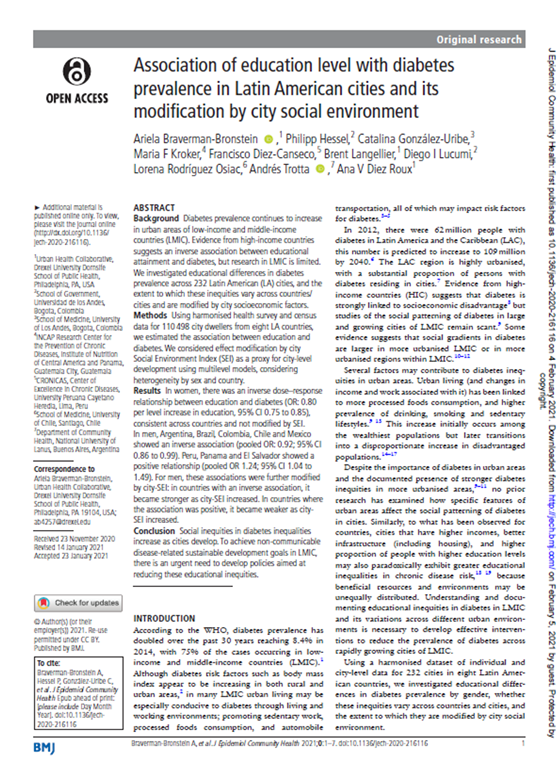
Association of education level with diabetes prevalence in Latin American cities and its modification by city social environment
This article published in the Journal of Epidemiology and Community Health investigated educational differences in diabetes prevalence by gender, whether these inequities vary across countries and cities, and the extent to which they are modified by city social environment.
Read
Download (PDF)

Life expectancy and mortality in 363 cities of Latin America
This article published in Nature Medicine describes variability and predictors of life expectancy and proportionate mortality in 363 cities across nine Latin American countries. The results highlight considerable heterogeneity in life expectancy and causes of death across cities of Latin America, revealing modifiable factors that could be amenable to urban policies aimed toward improving urban health in Latin America and more generally in other urban environments.
Read
Download (PDF)

COVID-19, Ambient Air Pollution, and Environmental Health Inequities in Latin American Cities
This commentary aimed to characterize COVID-19-related reductions in ambient PM2.5 in four major cities in Latin America and to estimate the magnitude of reductions in adult mortality if long-term exposure to PM2.5 was lower proportional to levels observed during the COVID-19 shutdowns.
Read
Download (PDF)

Social Inclusion and Physical Activity in Ciclovía Recreativa Programs in Latin America
This study aims to compare spatial trajectories in four Ciclovía Recreativa programs in Latin America (Bogotá, Mexico City, Santiago de Cali, and Santiago de Chile) according to socioeconomic characteristics and urban segregation of these cities; and to assess the relationship between participants’ physical activity (PA) levels and sociodemographic characteristics.
Read
Download (PDF)

Physical Disorders and Poor Self-Rated Health in Adults Living in Four Latin American Cities: A Multilevel Approach
This publication aims to to investigate the association between self-rated health and perceived urban environment characteristics among adults living in four Latin American cities.
Read
Download (PDF)

Web Data Mining: Validity of Data from Google Earth for Food Retail Evaluation
This publication aims to test the validity of web sources data for the assessment of community food retail environment by comparison to ground-truth observations (gold standard), as well as to test whether validity differs by type of food outlet and socioeconomic status (SES).
Read
Download (PDF)

Transformaciones Urbanas y Salud: Resultados de la Evaluación del TransMiCable
El resumen de resultados muestra la evaluación de las transformaciones observadas en múltiples dimensiones en el área de influencia del TransMiCable en Ciudad Bolívar, Bogotá. El estudio, realizado por miembros de SALURBAL, se llevó a cabo entre 2018 y 2020 con habitantes de Ciudad Bolívar y San Cristóbal con un equipo multidisciplinar y a través de metodologías mixtas.
Descargar (Español PDF)
Download (English PDF)

El Transporte Público Colectivo y el Transporte Activo en Tiempos de Pandemia
El transporte público colectivo y el transporte activo en tiempos de pandemia outlines key recommendations for adapting and supporting public mass transit and active transportation systems to promote safe, healthy, and equitable mobility in the context of the COVID-19 pandemic. This is the first brief in SALURBAL’s new mini-series, COVID-19 and Urban Health in Latin America.
Descargar (Español PDF)
Download (English PDF)
Baixar (Português PDF)

Food and beverage supply and advertising in schools and their surroundings in Metropolitan Lima. an exploratory study
The publication, originally published in Spanish, describes the offer and advertising of food and beverages in educational institutions and school environments of 15 public and private schools in Lima in 2019.
Read

Oferta y Publicidad de Alimentos y Bebidas en Instituciones Educativas y Entornos Escolares de Lima Metropolitana. Un Estudio Exploratorio
La publicación describe la oferta y la publicidad de alimentos y bebidas en instituciones educativas y entornos escolares de 15 colegios públicos y privados de Lima en 2019.
Read
Download (PDF)

Infant Mortality in Latin American Cities
This data brief describes how the Salud Urbana en América Latina ("Urban Health in Latin America") project (SALURBAL) is using data to describe patterns of infant mortality across Latin American cities and understand what characteristics of urban environments may be contributing to inequities in infant mortality.
Download (English PDF)
Descargar (Español PDF)
Baixar (Português PDF)

Characterising variability and predictors of infant mortality in urban settings: findings from 286 Latin American cities
This publication quantifies variability in infant mortality rates (IMR) across 286 Latin American cities and examined associations between urban characteristics and IMR in a cross-sectional design.
Read
Download (PDF)

Longitudinal changes in the retail food environment in Mexico and their association with diabetes
This publication describes changes in the composition of the retail food environment in Mexican neighborhoods from 2010 to 2016 and examines the association between these changes and diabetes cases diagnosed over the same period.
Read
Download (PDF)

Adolescent Tobacco Exposure in 31 Latin American Cities before and after the Framework Convention for Tobacco Control
This publication describes describe the prevalence and changes in tobacco use and tobacco control policies in Latin American countries and cities before and after ratification of the 2003 Framework Convention on Tobacco Control (FCTC).
Read
Download (PDF))

Could severe mobility and park use restrictions during the COVID-19 pandemic aggravate health inequalities? Insights and challenges from Latin America
This opinion article discusses how parks and "green spaces" offer psychological restoration and ease mental health challenges as well as provide opportunities for physical activity practices in social distance, but how they can also provide hubs for community transmissions.
Read
Download (PDF)

Promoting urban health equity in a post-COVID world: A view from Latin America
This briefing paper looks at the links between COVID-19 and urban health inequities, rooted in the Latin American context, and priorities for promoting urban health equity, climate resilience and sustainability following the pandemic.
Read
Download (PDF)

Urban health and health equity in Latin American cities: What COVID-19 is teaching us
This commentary highlights a few key lessons with major implications not only for COVID-19 but for urban health and health inequities, that are beginning to emerge during the pandemic.
Read
Download (PDF)

Park use, perceived park proximity, and neighborhood characteristics: Evidence from 11 cities in Latin America
SALURBAL researchers examine how park use may be associated with perceived park proximity, neighborhood-built environment and perceived social disorder in Latin American cities.
Read
Download (PDF)

Increases In Women’s Political Representation Associated With Reductions In Child Mortality In Brazil
SALURBAL researchers assessed the effects of female political representation on mortality among children younger than age five in Brazil and the extent to which this effect operates through coverage with conditional cash transfers and primary care services.
Read
Download (PDF)

Pandemics, cities and Public Health
Published in the Revista Ambiente & Sociedade, SALURBAL researchers examined changes in air pollution in São Paulo, Brazil during the COVID-19 pandemic. The team found that in São Paulo, reduced economic activity and a reduction in vehicle circulation contributed to a reduction by over 10% in environmental PM2.5 (fine particulate matter) in April 2020 compared to previous years.
Read
Download (PDF)

Bicycle safety in Bogotá: A seven-year analysis of bicyclists’ collisions and fatalities
Road safety research in low- and middle-income countries is limited, even though ninety percent of global road traffic fatalities are concentrated in these locations. In Colombia, road traffic injuries are the second leading source of mortality by external causes and constitute a significant public health concern in the city of Bogotá. Bogotá is among the top 10 most bike-friendly cities in the world. However, bicyclists are one of the most vulnerable road-users in the city. This study aims to determine the spatiotemporal trends in fatal and nonfatal collision rates and to identify the individual and contextual factors associated with fatal outcomes.
Read
Download (PDF)

Measuring Neighborhood Order and Disorder: a Rapid Literature Review
This review provides a summary of data collection methods, descriptive terms, and specific items employed to assess neighborhood disorder/order.
Read
Download (PDF)

Building a Methodological Foundation for Impactful Urban Planetary Health Science
Anthropogenic environmental change will heavily impact cities, yet associated health risks will depend significantly on decisions made by urban leaders across a wide range of non-health sectors, including transport, energy, housing, basic urban services, and others. A subset of planetary health researchers focus on understanding the urban health impacts of global environmental change, and how these vary globally and within cities.This report presents observations from a participatory workshop focused on challenges and opportunities for urban planetary health research.
Read
Download (PDF)
Evaluating the health effects of place-based slum upgrading physical environment interventions: A systematic review (2012-2018)
Rapid urbanization in low- and middle-income countries (LMIC) is associated with increasing population living in informal settlements. Inadequate infrastructure and disenfranchisement in settlements can create environments hazardous to health. Placed-based physical environment upgrading interventions have potential to improve environmental and economic conditions linked to health outcomes.
Summarizing and assessing evidence of the impact of prior interventions is critical to motivating and selecting the most effective upgrading strategies moving forward. Scientific and grey literature were systematically reviewed to identify evaluations of physical environment slum upgrading interventions in LMICs published between 2012 and 2018.
Read
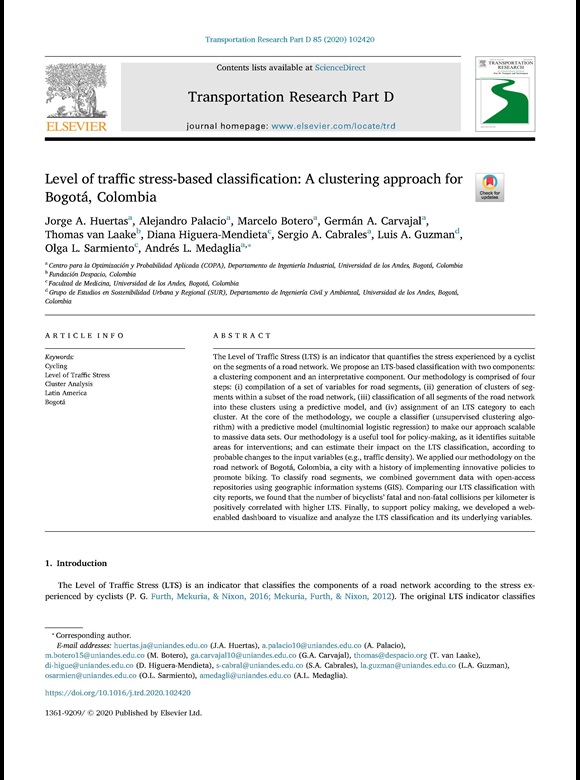
Level of traffic stress-based classification: A clustering approach for Bogotá, Colombia
The Level of Traffic Stress (LTS) is an indicator that quantifies the stress experienced by a cyclist on the segments of a road network. This publication proposes an LTS-based classification with two components: a clustering component and an interpretative component. The methodology is a useful tool for policy-making, as it identifies suitable areas for interventions; and can estimate their impact on the LTS classification, according to probable changes to the input variables.
Read
Download (PDF)

Health as driver for urban policy in Latin America: a scoping review of literature from international organizations
Understanding how health drives urban policies is critical for highlighting knowledge gaps and communicating evidence about health impacts to policymakers. This scoping review of grey literature examined the use of multiple health arguments and corresponding scientific evidence as justification for urban policies in Latin America. Generally, health arguments were generic, underdeveloped, healthcare-focused, and/or unfounded in scientific evidence. These findings highlight the need to more effectively communicate scientific evidence on the health impacts of urban policy.
Read
Download (PDF)

Revisión rápida: probabilidad de contagio por infecciones respiratorias agudas en el transporte público y medidas para mitigarlo
La publicación determina el nivel de evidencia sobre la probabilidad de transmisión de enfermedades respiratorias agudas en el transporte público, incluyendo transporte activo, identificando medidas en el uso del transporte público que pueden reducir la probabilidad de contagio por SARS-CoV-2 u otra infección respiratoria aguda de etiología viral.
Read
Download (PDF)

A systematic review of empirical and simulation studies evaluating the health impact of transportation interventions
Urban transportation is an important determinant of health and environmental outcomes, and therefore essential to achieving the United Nation's Sustainable Development Goals. To better understand the health impacts of transportation initiatives, we conducted a systematic review of longitudinal health evaluations involving: a) bus rapid transit (BRT); b) bicycle lanes; c) Open Streets programs; and d) aerial trams/cable cars. We also synthesized systems-based simulation studies of the health-related consequences of walking, bicycling, aerial tram, bus and BRT use.
Read
Download (PDF)

Urban Transformations and Health: Methods for TrUST—a Natural Experiment Evaluating the Impacts of a Mass Transit Cable Car in Bogotá, Colombia
TrUST (In Spanish: Transformaciones Urbanas y Salud: el caso de TransMiCable en Bogotá) is a quasi-experimental study using a mixed-methods approach.
Read
Download (PDF)

Knowledge to Policy Translation for Urban Health
How can urban health research drive the development of evidence-based policies? Knowledge to Policy Translation for Urban Health: Lessons from Latin American Cities explores how knowledge about the links between urban environments and health can inform action to promote urban health and health equity and contribute to environmental sustainability. The document reviews challenges and opportunities related to knowledge to policy translation for urban health in Latin America and presents concrete actions for improving how the research community engages with policymakers and other actors. (February 2020)
Download (English PDF)
Descargar (Español PDF)
Baixar (Português PDF)

Assessing Google Street View Image Availability in Latin American Cities
This study identifies patterns of Street View image availability, image age, and image age variance across cities in Latin America and assesses relationships between these measures and measures of resident socioeconomic conditions.
Read
Download (PDF)

Inequalities in Life Expectancy in Six Large Latin American Cities
This study reveals important differences in life expectancy within six Latin American cities. The findings highlight the importance of developing urban policies focused on reducing social inequalities and improving social and environmental conditions in the poorest neighborhoods in the region.
Read
Download (PDF)

Commute patterns and depression: Evidence from eleven Latin American cities
Although travel behavior is expected to influence personal health, few studies have examined associations with mental health. This study examines associations between commute patterns and mental health using survey data in 11 Latin American cities. The findings provide preliminary evidence that better access to mass transit systems and less congestion may be linked to better mental health among urban residents.
Read
Download (PDF)

The food environment in Latin America: a systematic review with a focus on environments relevant to obesity and related chronic diseases
Rising obesity and increasing recognition of the food environment's role in creating and addressing this challenge has led to increased attention on this topic within scientific literature in recent years. This study reviews literature describing the food environment in Latin America and policies targeting the food environment (FEP), as well as analytic studies that investigate associations between the FEP and dietary behaviors, overweight/obesity and obesity related chronic diseases. Findings suggest that health claims on food packaging are prevalent and mostly misleading; there is widespread use of marketing strategies for unhealthy foods aimed at children; and food prices are lower for processed relative to fresh foods. More work is needed to better understand policy impacts over time and the impacts of food prices and digital marketing on diet and health.
Read
Download (PDF)

Using community-based system dynamics modeling to understand the complex systems that influence health in cities: The SALURBAL study
This article describes the design, implementation, and results of a collaborative process designed to elucidate the complex systems that drive food behaviors, transport, and health in Latin American cities and to build capacity for systems thinking and community-based system dynamics (CBSD) methods among diverse research team members and stakeholders. During three CBSD workshops, 62 stakeholders from 10 Latin American countries identified 98 variables and a series of feedback loops that shape food behaviors, transportation and health, along with 52 policy levers. Our findings suggest that CBSD can engage local stakeholders, help them view problems through the lens of complex systems and use their insights to prioritize research efforts and identify novel solutions that consider mechanisms of complexity.
Read
Download (PDF)

A Novel International Partnership for Actionable Evidence on Urban Health in Latin America: LAC-Urban Health and SALURBAL
This article describes the origins and characteristics of an interdisciplinary multinational collaboration aimed at promoting and disseminating actionable evidence on the drivers of health in cities in Latin America and the Caribbean: The Network for Urban Health in Latin America and the Caribbean and the Wellcome Trust funded SALURBAL (Salud Urbana en América Latina, or Urban Health in Latin America) Project. Both initiatives have the goals of supporting urban policies that promote health and health equity in cities of the region while at the same time generating generalizable knowledge for urban areas across the globe. The processes, challenges, as well as the lessons learned to date in launching and implementing these collaborations, are described. By leveraging the unique features of the Latin American region (one of the most urbanized areas of the world with some of the most innovative urban policies), the aim is to produce generalizable knowledge about the links between urbanization, health, and environments and to identify effective ways to organize, design, and govern cities to improve health, reduce health inequalities, and maximize environmental sustainability in cities all over the world.
Read
Download (PDF)

Complex Systems Approaches to Diet: A Systematic Review
Complex systems approaches can help to elucidate mechanisms that shape population-level patterns in diet and inform policy approaches. This study reports results of a structured review of key design elements and methods used by existing complex systems models of diet.
Read
Download (PDF)
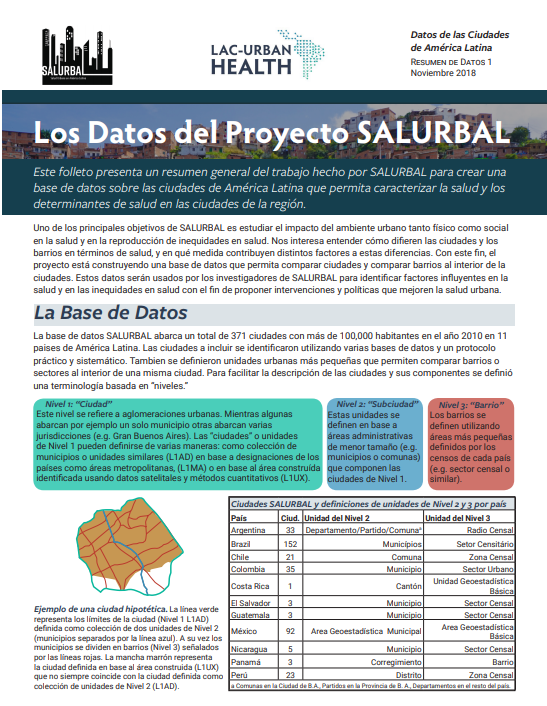
Data in the SALURBAL Project
Data in the SALURBAL Project provides an overview of the process of selecting cities, compiling data, and the types of questions the dataset may help to answer. The document was developed to inform future SALURBAL studies and to receive feedback from stakeholder working in urban health in the region regarding how SALURBAL research can support their efforts.
Download (English PDF)
Descargar (Español PDF)
Baixar (Português PDF)

Building a Data Platform for Cross-Country Urban Health Studies: the SALURBAL Study
Studies examining urban health and the environment must ensure comparability of measures across cities and countries. We describe a data platform and process that integrates health outcomes together with physical and social environment data to examine multilevel aspects of health across cities in 11 Latin American countries. We used two complementary sources to identify cities with ≥ 100,000 inhabitants as of 2010 in Argentina, Brazil, Chile, Colombia, Costa Rica, El Salvador, Guatemala, Mexico, Nicaragua, Panama, and Peru. We defined cities in three ways: administratively, quantitatively from satellite imagery, and based on country-defined metropolitan areas. In addition to "cities," we identified sub-city units and smaller neighborhoods within them using census hierarchies. Selected physical environment (e.g., urban form, air pollution and transport) and social environment (e.g., income, education, safety) data were compiled for cities, sub-city units, and neighborhoods whenever possible using a range of sources. Harmonized mortality and health survey data were linked to city and sub-city units. Finer georeferencing is underway. We identified 371 cities and 1436 sub-city units in the 11 countries. The median city population was 234,553 inhabitants (IQR 141,942; 500,398). The systematic organization of cities, the initial task of this platform, was accomplished and further ongoing developments include the harmonization of mortality and survey measures using available sources for between country comparisons. A range of physical and social environment indicators can be created using available data. The flexible multilevel data structure accommodates heterogeneity in the data available and allows for varied multilevel research questions related to the associations of physical and social environment variables with variability in health outcomes within and across cities. The creation of such data platforms holds great promise to support researching with greater granularity the field of urban health in Latin America as well as serving as a resource for the evaluation of policies oriented to improve the health and environmental sustainability of cities.
Read
Download (PDF)
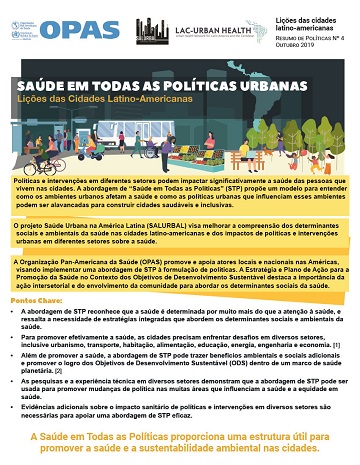
Health in All Urban Policies
Health in All Urban Policies: Lessons from Latin American Cities outlines the core principles of a Health in All Policies (HiAP) approach to understanding how urban environments affect health, and how urban policies and interventions across sectors can impact the health of people living in cities. This policy brief was co-produced by the SALURBAL project in collaboration with the Pan American Health Organization (PAHO) and describes initiatives by each organization to advance HiAP implementation. The 12-page booklet provides an introduction to key concepts related to HiAP, research and evidence to support this approach, and recommendations for policymakers and for the academic community for leveraging action across sectors to promote health, equity, and environmental sustainability.
Download (English PDF)
Descargar (Español PDF)
Baixar (Português PDF)

Mortality and Life Expectancy in Latin American Cities
Life expectancy and causes of death vary greatly across urban areas in Latin America, and global and regional summaries of life expectancy and causes of death can hide significant variability across cities. Urban environments that differ across neighborhoods, cities, and countries can have a major impact on life expectancy and causes of death. Mortality and Life Expectancy in Latin American Cities presents the experiences of the SALURBAL project in harmonizing and describing mortality data across 366 cities in 10 countries.
Download English (PDF)

Planning Health Evaluations of Housing and Neighborhood Interventions
Planning Health Evaluations of Housing and Neighborhood Interventions: Lessons from Latin America discusses opportunities to integrate health evaluations into the design and implementation of urban policies. Housing and neighborhood interventions can be important interventions that deliver packaged benefits to improve urban health and well-being, but more evidence is needed regarding their effects under different conditions and the pathways underlying these effects to inform policy changes. The policy brief details potential health effects and evaluation designs, recommendations for intersectoral planning, and shares three case studies of current evaluations from the SALURBAL project.
Download (English PDF)
Descargar (Español PDF)
Baixar (Português PDF)

Food and Urban Health
Food and Urban Health: Lessons from Latin America presents leading challenges in urban nutrition in the context of demographic changes, poverty, and markets and regulations. The policy brief describes mechanisms that can be implemented to affect food-related behaviors and consumption, and highlights innovative policies, laws, and programs from the region. Recommendations build upon best regional practices and suggest integrated and intersectoral responses.
Download (English PDF)
Descargar (Español PDF)
Baixar (Português PDF)

Sustainable Transport and Urban Health
Sustainable Transport and Urban Health: Lessons from Latin American Cities explores strategies and interventions from throughout the region that support active transport and mobility in cities. The policy brief gives an overview of the key areas of transportation policies, regional trends, case studies of policies in major cities, and discusses the contributions of Latin America to global efforts in urban policies and health.
Download (English PDF)
Descargar (Español PDF)
Baixar (Português PDF)